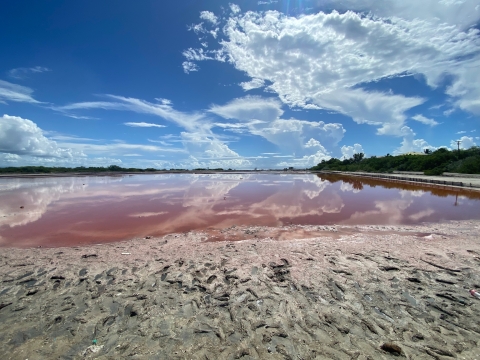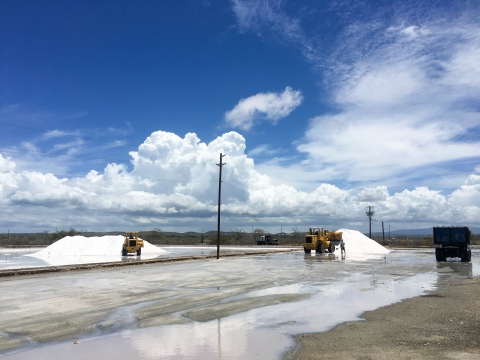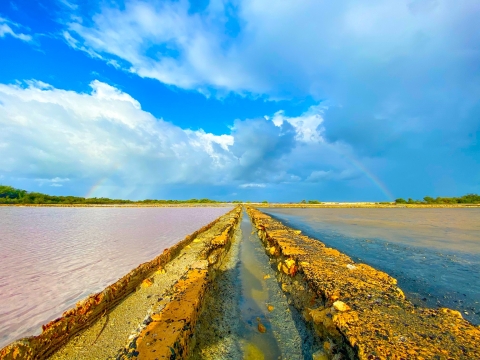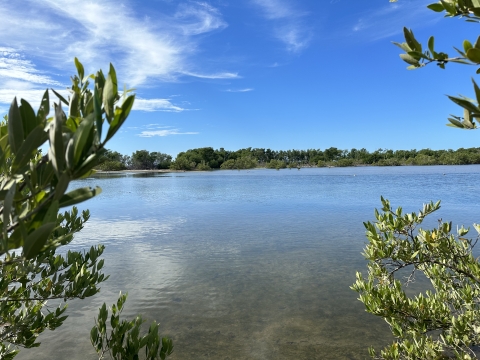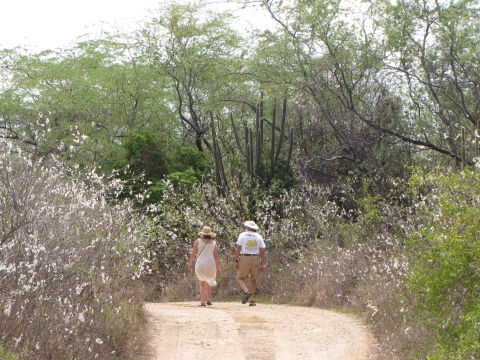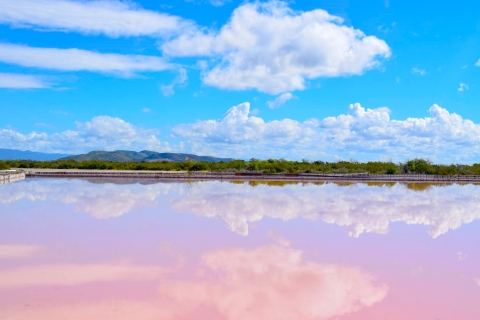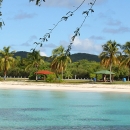About Us
The Cabo Rojo National Wildlife Refuge was established in 1974 for its indispensable and unique value in “carrying out the national migratory bird management program”. In 1999 the Cabo Rojo Salt Flats, mangrove fringes, and uplands were added to the refuge for a total of 1,836 acres of land dedicated to protecting one of the most important shorebird habitats in the Caribbean.
This refuge is one of nine refuges that encompass the Caribbean Islands National Wildlife Refuge Complex. The Caribbean islands make up one of the most diverse ecosystems within the United States, Puerto Rico, and the U.S. Virgin Islands.
These ecosystems provide numerous opportunities to protect and restore tropical forests, neotropical migratory bird wintering grounds, and habitat for more than 78 threatened or endangered species. To date, 245 plant species and 145 bird species have been identified at Cabo Rojo National Wildlife Refuge.
Our Mission
The Cabo Rojo National Wildlife Refuge’s main objectives include:
- Restoring and enhancing native wildlife and plants, particularly the endangered yellow-shouldered blackbird (Agelaius xanthomus) and the endangered grass Aristida chaseae.
- Increasing the level of environmental awareness among students, residents, and visitors.
- Protecting one of the most important shorebird habitats in the Caribbean.
Our History
The Cabo Rojo National Wildlife Refuge was originally home to the Foreign Broadcast Information Service (FBIS) in Puerto Rico. The FBIS was an open-source intelligence service run by the U.S. Central Intelligence Agency (CIA) from 1941-2004. The purpose of this facility was to monitor, translate, and disseminate radio broadcasts from selected foreign countries.
The refuge was established in 1974, when 587 acres of land were obtained from the CIA as an upland buffer for the Cabo Rojo Salt Flats (a potential Western Hemisphere Shorebird reserve), and as a potential habitat for migratory birds. However, U.S. Fish and Wildlife Service did not have a presence on the refuge until 1978 when the first manager was hired. In 1999 the Service purchased 1,269 acres of salt flats, mangrove fringes, and uplands from the Carrera family to protect important shorebird habitat. The refuge currently consists of 1,856 acres. The Cabo Rojo Salt Flats (part of the Cabo Rojo NWR) are managed by USFWS, but the salt harvesting is operated by a private entity.
The water levels at the Salt Flats are managed with the needs of shorebirds in mind. Afterall, this area is considered the most important stopover for migratory birds and shorebirds in the entire Eastern Caribbean. Migratory birds use the refuge during the cooler months while resident bird species are present year-round. However, the water levels are also controlled considering the requirements for the commercial salt-harvesting process. The salt mining industry in the Cabo Rojo Salt Flats is the first industry in Puerto Rico's history. Preserving the socioeconomic value and historical culture of the land is also of great importance.
For centuries, the native Taínos collected salt for different purposes. When the Spaniards arrived, salt mining became an economic and industrial endeavor. On July 25th, 1511, the Spanish crown authorized the exploitation of the salt production industry. Multiple confrontations arose between powerful European nations during the XVII and XVIII centuries. Fights over this valuable land and resource ensued. These struggles were also among the Puerto Rican inhabitants.
In 1769, residents of the town of Aguada fought against the Cabo Rojo Salt Flats workers in an attempt to take control of the Salt Flats. Since then, the people of Cabo Rojo are often referred to as “mata con hacha’’ or “those who kill with axes”, and the beach in which the battle took place is known as “El Combate” or “The Combat”. Throughout the XIX and XX centuries, hundreds of people worked at the Salt Flats under extreme conditions. This led to a strike in 1939, marking an important event in the Puerto Rican labor movement. After 1940, salt production began to decline due to the increasing popularity of refrigeration. However, the Cabo Rojo Salt Flats continued operating, primarily for agricultural and pharmaceutical purposes. This production of salt is essential for the balance of the Salt Flat ecosystem which in turn is crucial for migratory and resident bird species.
Our Habitats
The land occupied by the refuge was used for cattle ranching and agricultural purposes for five centuries prior to Service ownership. Due to this, much of the native vegetation had been replaced by plants from other regions, which left much of the land barren, except for a limited number of trees in drainages and near homesteads. With the elimination of cattle grazing, the habitat has changed considerably, becoming overgrown with exotic forage grass species and exotic trees, especially mesquite. The native vegetation is classified as subtropical dry forest under the Holdridge classification of world life zones.
The refuge lies along a coastal plain and has a few gently rolling hills overlooking the southwestern tip of Puerto Rico. These hills lie within the subtropical dry forest belt. Presently, the refuge consists of approximately 65% forest and 35% grassland. The 1,836 acres of land are of substantial value as they serve as habitat for migratory and resident birds. At least 245 plant species and 145 bird species have been identified on the refuge. Some of the bird species include Puerto Rican Tody, Adelaide’s Warbler, Caribbean Elaenia, Turpial, the endangered Yellow-shouldered Blackbird, and Piping Plover. Although bats are the only native living land mammals in Puerto Rico, introduced mammals that can be found on the refuge include the small Indian mongoose and the African Paras Monkey.
The Cabo Rojo NWR Salt Flats Unit is characterized by the wide variety of ecosystems found in the area. Among them we can find hypersaline lagoons, mangrove forests, and the subtropical dry forest.
___________________________________________________________________________________________________________
Hypersaline Lagoons
These are high-salinity pools formed by tidal flooding in flat areas. They are characterized by the water’s fast evaporation and by salt crystal formation. This kind of lagoon is inhabited by shrimp, insect larvae, algae, bacteria, and aquatic insects. This attracts birds that arrive searching for a source of food.
___________________________________________________________________________________________________________
Mangrove Forests
These forests are adapted to survive in environments with high salinity and low oxygen levels. Throughout the world, there are about 80 mangrove tree species. In Puerto Rico, we have four of them: Red Mangrove (Rhizophora mangle), Black Mangrove (Avicennia germinans), White Mangrove (Languncularia racemosa), and Buttonwood Mangrove (Conocarpus erectus). Some adaptations and characteristics of mangroves are the following: tolerance to high levels of salinity, aerial roots, and floating seeds. Mangrove forests protect the coast from erosion and help reduce the impact of hurricanes and tsunamis. Mangroves also absorb high levels of carbon dioxide (greenhouse gas) from the atmosphere and store it (carbon sequestration); preventing these emissions from contributing to global warming.
___________________________________________________________________________________________________________
Subtropical Dry Forest
This is a zone receiving between 30 - 35 inches (0.76 - 0.88 meters) of annual rainfall and with temperatures averaging between 80° F in the shade to 100° F in exposed areas (26° C and 37° C respectively). The plants are adapted to survive in these extreme conditions. They may have thorns, waxy leaves to prevent water loss during transpiration, and/or shed their leaves simultaneously to reduce water loss during droughts.
___________________________________________________________________________________________________________
Fun Fact
Have you noticed the pinkish color of the Salt Flats?
A high-salinity resistant microalgae called Dunaliella salina is responsible. Brine shrimp (Artemia franciscana) feed on these microalgae and acquire its peculiar pink color. This shrimp species is also an important food source for birds. For example, this shrimp species is what gives flamingoes their famous pink hue.
___________________________________________________________________________________________________________
Other Facilities in this Complex
Cabo Rojo National Wildlife Refuge is one of the nine refuges that make up the Caribbean Islands National Wildlife Refuge Complex. Each refuge in the complex plays a vital role in conserving our unique, endemic species and resources in the Caribbean. The Cabo Rojo NWR is home to the headquarters of the complex.

